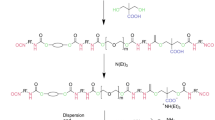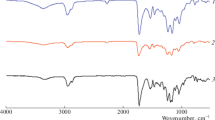Abstract
The waterborne polyurethane (WPU) with different carboxylic acid group contents were prepared by a prepolymer method, adopting polycarbonate diol (PCDL) as soft segments and isophorone diisocyanate (IPDI) as hard segments. The different amounts of 2,2-dimethylolbutyric acid (DMPA) as hydrophilic chain extender were introduced into polyurethane molecular for studying the effect on microstructure and properties. The solid content, pH value and viscosity measurement were used to characterize the performance of WPU emulsion. The fourier transform infrared spectroscopy (FT-IR), X-ray diffraction (XRD), thermogravimetric (TG), differential scanning calorimetry (DSC), dynamic mechanical analysis (DMA), water contact angle tester and mechanical testing machine were utilized to measure the structure, crystallization performance, thermal stability, low temperature flexibility, wetting performance and mechanical properties of WPU films, respectively. The test value of impact, adhesive, flexibility and pencil hardness on tinplate of WPU coatings were obtained for observing film properties. The results indicated that the emulsification effect increase with the increased DMPA contents. The decomposition temperature of WPU films perform a slight decrease and the WPU films have excellence low temperature flexibility with the increased DMPA contents. The hydrophilic property of WPU films mainly are about 80°and the tensile strength value of 7 wt% WPU reaches 45 MPa and elongation at break at 420%.








Similar content being viewed by others
References
Pavličević J, Špirkova M, Strachota A, Szécsényi KM, Lazić N, Budinski-Simendić J (2010) The influence of montmorillonite and bentonite addition on thermal properties of polyurethanes based on aliphatic polycarbonate diols. Thermochim Acta 509:73–80
Shendi HK, Omrani I, Ahmadi A, Farhadian A, Babanejad N, Nabid MR (2017) Synthesis and characterization of a novel internal emulsifier derived from sunflower oil for the preparation of waterborne polyurethane and their application in coatings. Prog Org Coat 105:303–309
Sardon H, Irusta L, González A, Fernández-Berridi MJ (2013) Waterborne hybrid polyurethane coatings functionalized with (3-aminopropyl)triethoxysilane: adhesion properties. Prog Org Coat 76:1230–1235
Lee YJ, Kim BS, Hong JH, Park S, Kim H, Kim IS (2012) Enhanced mechanical properties and pre-tension effects of polyurethane (PU) nanofiber filaments prepared by electrospinning and dry twisting. J Polym Res 19:9774
Xiao Y, Jiang L, Liu ZM, Yuan Y, Yan PY, Zhou CL, Lei JX (2017) Effect of phase separation on the crystallization of soft segments of green waterborne polyurethanes. Polym Test 60:160–165
Kuan HC, Ma CM, Chang WP, Yuen SM, Wu HH, Lee TM (2005) Synthesis, thermal, mechanical and rheological properties of multiwall carbon nanotube/waterborne polyurethane nanocomposite. Compos Sci Technol 65:1703–1710
Kwei TK (1982) Phase separation in segmented polyurethanes. J Appl Polym Sci 27:2891–2899
Li YJ, Kang WX, Stoffer JO, Chu B (1994) Effect of hard-segment flexibility on phase separation of segmented polyurethanes. Macromolecules 27:612–614
Fang CQ, Zhou X, Yu Q, Liu SL, Guo DG, Yu RE, Hu JB (2014) Synthesis and characterization of low crystalline waterborne polyurethane for potential application in water-based ink binder. Prog Org Coat 77:61–71
Noble KL (1997) Waterborne polyurethanes. Prog Org Coat 32:131–136
Ghosh B, Gogoi S, Thakur S, Karak N (2016) Bio-based waterborne polyurethane/carbon dot nanocomposite as a surface coating material. Prog Org Coat 90:324–330
Chen JJ, Zhu CF, Deng HT, Qin ZN, Bai YQ (2009) Preparation and characterization of the waterborne polyurethane modified with nanosilica. J Polym Res 16:375–380
Al-Sabagh AM, Atta AM (1999) Water-based non-ionic polymeric surfactants as oil spill dispersants. J Chem Technol Biotechnol 74:1075–1081
Ramesh D, Vasudevan T (2009) Synthesis and physico-chemical evaluation of water-soluble epoxy ester primer coating. Prog Org Coat 66:93–98
Kristoffersson A, Roncari E, Galassi C (1998) Comparison of Dierent binders for water-based tape casting of alumina. J Eur Ceram Soc 18:2123–2131
Pardini OR, Amalvy IJ (2008) FTIR, 1H-NMR spectra, and thermal characterization of water-based polyurethane/acrylic hybrids. J Appl Polym Sci 107:1207–1214
Nanda AK, Wicks DA (2006) The influence of the ionic concentration, concentration of the polymer, degree of neutralization and chain extension on aqueous polyurethane dispersions prepared by the acetone process. Polymer 47:1805–1811
Fuensanta M, Jofre-Reche JA, Rodríguez-Llansola F, Costa V, Martín-Martínez JM (2018) Structure and adhesion properties before and after hydrolytic ageing of polyurethane urea adhesives made with mixtures of waterborne polyurethane dispersions. Int J Adhes Adhe 85:165–176
Yoon Jang J, Kuk Jhon Y, Woo Cheong I, Hyun Kim J (2002) Effect of process variables on molecular weight and mechanical properties of water-based polyurethane dispersion. Colloids Surf A Physicochem Eng Asp 196:135–143
García-Pacios V, Jofre-Reche JA, Costa V, Colera M, Martín-Martínez JM (2013) Coatings prepared from waterborne polyurethane dispersions obtained with polycarbonates of 1,6-hexanediol of different molecular weights. Prog Org Coat 76:1484–1493
García-Pacios V, Costa V, Colera M, Martín-Martínez JM (2011) Waterborne polyurethane dispersions obtained with polycarbonate of hexanediol intended for use as coatings. Prog Org Coat 71:136–146
García-Pacios V, Costa V, Colera M, Martín-Martínez JM (2010) Affect of polydispersity on the properties of waterborne polyurethane dispersions based on polycarbonate polyol. Int J Adhes Adhes 30:456–465
García-Pacios V, Colera M, Iwata Y, Martín-Martínez JM (2013) Incidence of the polyol nature in waterborne polyurethane dispersions on their performance as coatings on stainless steel. Prog Org Coat 76:1726–1729
Liu N, Zhao YH, Kang MQ, Wang JW, Wang XK, Feng YL, Yin N, Li QF (2015) The effects of the molecular weight and structure of polycarbonatediols on the properties of waterborne polyurethanes. Prog Org Coat 82:46–56
Jofre-Reche JA, García-Pacios V, Costa V, Colera M, Martín-Martínez JM (2015) Role of the interactions between carbonate groups on the phase separation and properties of waterborne polyurethane dispersions prepared with copolymers of polycarbonate diol. Prog Org Coat 88:199–211
Rahman MM, Kim HD (2006) Synthesis and characterization of waterborne polyurethane adhesives containing different amount of ionic groups (I). J Appl Polym Sci 102:5684–5691
Pérez-Limiñana MA, Arán-Aís F, Torró-Palau AM, Orgilés-Barceló AC, Martín-Martínez JM (2005) Characterization of waterborne polyurethane adhesives containing different amounts of ionic groups. Int J Adhes Adhes 25:507–517
Špírková M, Hodan J, Kredatusová J, Poręba R, Uchman M, Serkis-Rodzeń M (2018) Functional properties of films based on novel waterborne polyurethane dispersions prepared without a chain-extension step. Prog Org Coat 123:53–62
Acknowledgements
The authors wish to thank for the Sichuan University of Science and Engineering Talent Introduction Project (No.2016RCL35), the Innovation Fund of Postgraduate (Y2018045) Sichuan University of Science & Engineering, Provincial College Students’ Innovation and Entrepreneurship Training Program (201810622036), Opening Project of Key Laboratories of Fine Chemicals and Surfactants in Sichuan Provincial Universities (2018JXY04) and Major Project of Education Department in Sichuan (18ZA0346).
Author information
Authors and Affiliations
Contributions
Linqing Hu and Zejun Pu contributed equally to this work, and they are the co-first author. Besides, all the authors approved the final version of the manuscript.
Corresponding authors
Additional information
Publisher’s note
Springer Nature remains neutral with regard to jurisdictional claims in published maps and institutional affiliations.
Rights and permissions
About this article
Cite this article
Hu, L., Pu, Z., Zhong, Y. et al. Effect of different carboxylic acid group contents on microstructure and properties of waterborne polyurethane dispersions. J Polym Res 27, 129 (2020). https://doi.org/10.1007/s10965-020-02125-1
Received:
Accepted:
Published:
DOI: https://doi.org/10.1007/s10965-020-02125-1




